
Borovo, also known as Borovo Selo, is a village and a municipality in Vukovar-Syrmia County in eastern part of Croatia. Situated on the banks of the Danube river, it shares its border with Serbia and the municipality of Bač on the opposite side. The historical development of Borovo is intricately linked with the Danube, which has played a pivotal role in its development as a notable industrial hub in the region.

The Battle of Vukovar was an 87-day siege of Vukovar in eastern Croatia by the Yugoslav People's Army (JNA), supported by various paramilitary forces from Serbia, between August and November 1991. Before the Croatian War of Independence the Baroque town was a prosperous, mixed community of Croats, Serbs and other ethnic groups. As Yugoslavia began to break up, Serbia's President Slobodan Milošević and Croatia's President Franjo Tuđman began pursuing nationalist politics. In 1990, an armed insurrection was started by Croatian Serb militias, supported by the Serbian government and paramilitary groups, who seized control of Serb-populated areas of Croatia. The JNA began to intervene in favour of the rebellion, and conflict broke out in the eastern Croatian region of Slavonia in May 1991. In August, the JNA launched a full-scale attack against Croatian-held territory in eastern Slavonia, including Vukovar.
The Battle of Borovo Selo of 2 May 1991, known in Croatia as the Borovo Selo massacre and in Serbia as the Borovo Selo incident, was one of the first armed clashes in the conflict which became known as the Croatian War of Independence. The clash was precipitated by months of rising ethnic tensions, violence, and armed combat in Pakrac and at the Plitvice Lakes in March. The immediate cause for the confrontation in the heavily ethnic Serb village of Borovo Selo, just north of Vukovar, was a failed attempt to replace the Yugoslav flag in the village with the flag of Croatia. The unauthorised effort by four Croatian policemen resulted in the capture of two by a Croatian Serb militia in the village. To retrieve the captives, the Croatian authorities deployed additional police, who drove into an ambush. Twelve Croatian policemen and one Serb paramilitary were killed before the Yugoslav People's Army (JNA) intervened and put an end to the clashes.

Trpinja is a village and an eponymous municipality in the Vukovar-Syrmia County in eastern Croatia. The village is located on the D55 road between Osijek and Vukovar. Landscape of the Trpinja Municipality is marked by the Pannonian Basin plains and agricultural fields of maize, wheat, common sunflower and sugar beet.
The Lovas killings involved the killing of 70 Croat civilian residents of the village of Lovas between 10 and 18 October 1991, during the Croatian War of Independence. The killings took place during and in the immediate aftermath of the occupation of the village by the Yugoslav People's Army (JNA) supported by Croatian Serb forces and Dušan the Mighty Forces. on 10 October, two days after Croatia declared independence from Yugoslavia. The occupation occurred during the Battle of Vukovar, as the JNA sought to consolidate its control over the area surrounding the city of Vukovar. The killings and abuse of the civilian population continued until 18 October, when troops guarding a group of civilians forced them to walk into a minefield at gunpoint and then opened fire upon them.

Blago Zadro was a commander of the northern part of Croatian forces in Vukovar during the Croatian War of Independence. He was killed in an attack by the Yugoslav People's Army (JNA) in the town of Borovo Naselje.
The Dalj massacre was the killing of Croats in Dalj, Croatia from 1 August 1991 until June 1992, during the Croatian War of Independence. In addition to civilian victims, the figure includes 20 Croatian policemen, 15 Croatian National Guard troops and four civil defencemen who had been defending the police station and water supply building in the village on 1 August 1991. While some of the policemen and the ZNG troops died in combat, those who surrendered were killed after they became prisoners of war. They tried to fight off an attack by the Croatian Serb SAO Eastern Slavonia, Baranja and Western Syrmia Territorial Defence Forces, supported by the Yugoslav People's Army and the Serb Volunteer Guard paramilitaries. The SAO SBWS was declared an autonomous territory in eastern Croatia following the Battle of Borovo Selo just to the south of Dalj.

Antin is a village located 18 km northwest of Vinkovci in Vukovar-Syrmia County, Croatia. Population 731.
Mile Dedaković is a retired Croatian Army colonel. Also known by his nom de guerreJastreb ("Hawk"), Dedaković is best known for commanding the 204th Vukovar Brigade and the city of Vukovar's defenses during the 1991 Battle of Vukovar in the early stages of the Croatian War of Independence.
The Varivode massacre was a mass killing that occurred on 28 September 1995 in the village of Varivode, Croatia during the Croatian War of Independence. According to United Nations officials, soldiers of the Croatian Army (HV) and Croatian police killed nine Serb villagers, all of whom were between the ages of 60 and 85. After the war, six former Croatian soldiers were tried for committing crimes in the village, but were all eventually released due to lack of evidence. In 2012, the Supreme Court of Croatia ruled that the Republic of Croatia was responsible for the killings, dubbing the massacre an "act of terrorism," and the following year the municipal court in Knin announced that the Government of Croatia must provide compensation to the children of a couple who were murdered.

The order of battle of the Croatian Special Police Units in 1991–1995 included up to 30 individual special forces units subordinated to the Ministry of the Interior. The special police was created around the Ministry of the Interior's existing airborne special forces unit following an open revolt of the Croatian Serbs against the Government of Croatia in August 1990. It further developed with the increasing involvement of the Yugoslav People's Army in the conflict, supporting the Croatian Serbs. The conflict escalated into the Croatian War of Independence in 1991. The special police took part in the first clashes of the war in Pakrac and at the Plitvice Lakes. As Croatia had no army, the 3,000-strong special forces became the country's most effective fighting force.

The Serbs of Vukovar are one of traditional communities living in the multicultural, multi-ethnic and multi-confessional eastern Croatian town of Vukovar on the border with Serbia. The Serb community constitutes slightly over one third of the entire population of Vukovar according to 2011 Census. Other significant communities include the Croat majority, as well as Hungarians, Slovaks, Rusyns, Ukrainians and historically Yugoslavs, Germans, Jews, Vlachs and Turks.
The Battle of Kusonje was a two-day clash fought in the village of Kusonje near the town of Pakrac on 8–9 September 1991, during the Croatian War of Independence. The battle was initiated when a platoon of the Croatian National Guard was ambushed by Croatian Serb forces while conducting a reconnaissance patrol. The ZNG deployed reinforcements to extract the ambushed platoon, but failed to reach them. The surviving members of the platoon held out until they ran out of ammunition and surrendered only to be killed by their captors and buried in a mass grave.

The Church of St. George in Tovarnik is a Serbian Orthodox church in eastern Croatia built in 1799. Together with the Orthodox church in Ilok and Church of the Holy Venerable Mother Parascheva, it is under the spiritual jurisdiction of the Eparchy of Srem with the seat in Sremski Karlovci, contrary to most of the other Serbian Orthodox churches in eastern Croatia that are under the Eparchy of Osječko polje and Baranja.
The Berak killings was the mass murder of Croat civilians by Serb rebels and paramilitaries from September until December 1991, in the village of Berak, near Vukovar, during the Croatian War of Independence.
The Petrinja Killings refers to a series of mass murders and other crimes that were committed by various Serb forces against Croat POWs and civilians, from September 1991 until June 1992, in the town of Petrinja and in surrounding areas.
The 1991 killings of Serbs in Vukovar were a series of incidents in which Serbs living in and around Vukovar during the spring and summer of 1991 were subject to kidnappings and summary executions by armed thugs associated with the Croatian National Guard. These events began as the Croatian War of Independence was starting, prior to the start of the Battle of Vukovar in August of the same year. After the war, some criminal investigations were undertaken, including one of the notable perpetrators Tomislav Merčep, though on the whole the matter remains largely unresolved.









